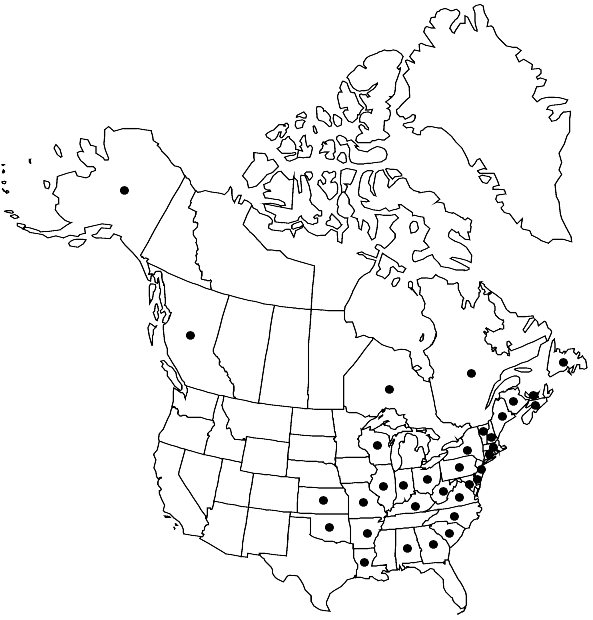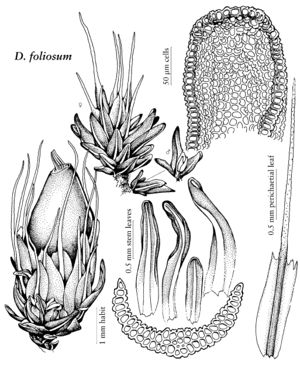Difference between revisions of "Diphyscium foliosum"
Observ. Bot., 35. 1803,.
FNA>Volume Importer |
imported>Volume Importer |
||
| (6 intermediate revisions by 2 users not shown) | |||
| Line 6: | Line 6: | ||
|place=35. 1803, | |place=35. 1803, | ||
}} | }} | ||
| − | |basionyms={{Treatment/ID/ | + | |basionyms={{Treatment/ID/Basionym |
|name=Buxbaumia foliosa | |name=Buxbaumia foliosa | ||
|authority=Hedwig | |authority=Hedwig | ||
| + | |rank=species | ||
| + | |publication_title=Sp. Musc. Frond., | ||
| + | |publication_place=166. 1801 | ||
}} | }} | ||
|synonyms= | |synonyms= | ||
| Line 25: | Line 28: | ||
|elevation=low to moderate elevations (50-1000 m) | |elevation=low to moderate elevations (50-1000 m) | ||
|distribution=B.C.;N.B.;Nfld. and Labr. (Nfld.);N.S.;Ont.;P.E.I.;Que.;Ala.;Alaska;Ark.;Conn.;Del.;Ga.;Ill.;Ind.;Kans.;Ky.;La.;Maine;Md.;Mass.;Mo.;N.H.;N.J.;N.Y.;N.C.;Ohio;Okla.;Pa.;S.C.;Vt.;Va.;W.Va.;Wis.;Mexico;Central America (Guatemala);Europe;Asia;Atlantic Islands (Azores;Iceland;Madeira). | |distribution=B.C.;N.B.;Nfld. and Labr. (Nfld.);N.S.;Ont.;P.E.I.;Que.;Ala.;Alaska;Ark.;Conn.;Del.;Ga.;Ill.;Ind.;Kans.;Ky.;La.;Maine;Md.;Mass.;Mo.;N.H.;N.J.;N.Y.;N.C.;Ohio;Okla.;Pa.;S.C.;Vt.;Va.;W.Va.;Wis.;Mexico;Central America (Guatemala);Europe;Asia;Atlantic Islands (Azores;Iceland;Madeira). | ||
| − | |discussion=<p>In western North America, Diphyscium foliosum is terrestrial in tundra sites, often in blowouts; it is also found as humid perpendicular sods pendent from ledges and on rock in canyon walls; in eastern North America it is found on banks and horizontal surfaces in forests. The unique golf-tee-like protonemal flaps, which can be excavated from the rhizoids, are a distinctive family trait.</p> | + | |discussion=<p>In western North America, <i>Diphyscium foliosum</i> is terrestrial in tundra sites, often in blowouts; it is also found as humid perpendicular sods pendent from ledges and on rock in canyon walls; in eastern North America it is found on banks and horizontal surfaces in forests. The unique golf-tee-like protonemal flaps, which can be excavated from the rhizoids, are a distinctive family trait.</p> |
|tables= | |tables= | ||
|references={{Treatment/Reference | |references={{Treatment/Reference | ||
| Line 37: | Line 40: | ||
-->{{#Taxon: | -->{{#Taxon: | ||
name=Diphyscium foliosum | name=Diphyscium foliosum | ||
| − | |||
|authority=(Hedwig) D. Mohr | |authority=(Hedwig) D. Mohr | ||
|rank=species | |rank=species | ||
| Line 52: | Line 54: | ||
|publication year= | |publication year= | ||
|special status= | |special status= | ||
| − | |source xml=https:// | + | |source xml=https://bitbucket.org/aafc-mbb/fna-data-curation/src/2e0870ddd59836b60bcf96646a41e87ea5a5943a/coarse_grained_fna_xml/V27/V27_205.xml |
|genus=Diphyscium | |genus=Diphyscium | ||
|species=Diphyscium foliosum | |species=Diphyscium foliosum | ||
Latest revision as of 21:24, 5 November 2020
Plants dark green to brownish, dull, forming hard tufts. Stems unbranched, erect, 0.5–1 mm, strongly radiculose. Leaves 0.5–4 mm, crisped and imbricate when dry, margins entire or weakly toothed with papillae, apex blunt, the most proximal leaves shorter than the most distal, laminal cells mammillose or papillose through most of lamima. Perichaetial leaves brownish when mature, with spinulose awn, lamina at awn base lacerate and membranaceous. Capsule broadly ovoid, (2–)3–4 mm, stomata phaneropore near capsule base; mature sporangium emergent from spreading perichaetium. Spores 6–8 µm.
Phenology: Capsules mature early summer.
Habitat: Soil banks and soil of forest floors, also in tundras
Elevation: low to moderate elevations (50-1000 m)
Distribution

B.C., N.B., Nfld. and Labr. (Nfld.), N.S., Ont., P.E.I., Que., Ala., Alaska, Ark., Conn., Del., Ga., Ill., Ind., Kans., Ky., La., Maine, Md., Mass., Mo., N.H., N.J., N.Y., N.C., Ohio, Okla., Pa., S.C., Vt., Va., W.Va., Wis., Mexico, Central America (Guatemala), Europe, Asia, Atlantic Islands (Azores, Iceland, Madeira).
Discussion
In western North America, Diphyscium foliosum is terrestrial in tundra sites, often in blowouts; it is also found as humid perpendicular sods pendent from ledges and on rock in canyon walls; in eastern North America it is found on banks and horizontal surfaces in forests. The unique golf-tee-like protonemal flaps, which can be excavated from the rhizoids, are a distinctive family trait.
